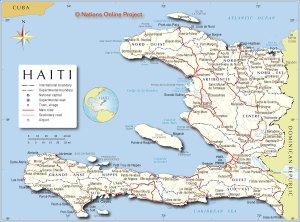For general information about the country profiles click here.
 Population: 10,173,775
Population: 10,173,775
HDI ranking: 161/187
HDI score: 0.456
Since local governments were created in 1987, the situation on decentralization of local governments has not changed. Although Haiti entered a transition phase following the 2006 election and the adaption of five decrees, local authorities still need the legal framework and capacity building (USAID, 2006).
Local governance at a glance
- Haiti can be divided into 10 departments, 41 arroundisements, and 133 communes or municipalities (ARIAL, 2010).
- A prefect appointed by the central government heads each department, and an elected mayor is at the head of municipality. Municipal councils are elected every 4 year (ARIAL, 2010).
- There are no legislated gender quotas at the subnational level (QuotaProject, 2013).
Civil society actors include
- Association femmes soleil d`Haiti (AFASDA) works to organize women to advocate for social change and to bring about greater participation of women in Haitian society. Focused areas include women’s political representation.
- Groupe de Recherches et d’Interventions en Education Alternative (GRIEAL) has carried out research and developed training modules on decentralization (USAID, 2000).
- Plateforme Haitienne de Plaidoyer pour un Developpement Alternatif (PAPDA) and Initiative Democratique (ID) work on advocacy of decentralization (USAID, 2000).
- Initiative Committees (ICs) is a community action group which is continuing to build bridge with government leaders to improve community life.
Capacity building institutions
- National Federation of mayors (FENAMH: Fédération Nationale des Associations des Maires) rooted in ten regional associations of mayors (USAID, 2000).
- Fondation Nationale des Communal Administrative Councils Démocratiques (FONACAD) is a professional association of administrative councils of communal sections (USAID, 2000).
Fiscal control
- Communes have no legal authority to collect and modify local taxes, to impose new taxes, or to incur or recover debt (DAI, 1999).
- Local governments receive budget allocations from the Department of Finance through the Department of Interior. Fonds de Gestion et de Développement des Collectivités Territoriales (FGDCT) which was created in 1996 is the only source of government transfers. 50% of FGDCT is allocated to local governments and then divided among local governments in a predetermined ratio (USAID, 2006).
Key initiatives for participatory local governance
- The Haitian Constitution of 1987 provided decentralization and local government by subdividing the country and instating local councils (ARIAL, 2010).
- Because mayors and Conseils d’Administration de la Section Communale (CASECs), the smallest unit of local governments, has been selected by population since 1995, people begun to form associations to articulate and exchange ideas or to plan and carry out activities in collaboration with local authorities (DAI, 1999).
- A transitional government made plans to re-energize democratic reform after the political unrest occurred in between 2001 and 2004 (ARIAL, 2010).
- In 2006, the interim government adopted five decrees that define the mission and duties of the three levels of government collectivities and also contain the principles to facilitate training elected local officials and civil organizations (USAID, 2006).
- The Action Plan for national recovery from 2010 earthquake focuses more specifically on a regional approach and local government was put at the forefront of the reconstruction of Haiti in international aid efforts (ARIAL, 2010).
Challenges for participatory local governance
- There are no legal reforms and planned efforts to increase the scope of existing legislation concerning local authorities (ARIAL, 2010).
- Municipalities lack the capacity, funding, and authority to function, so training elected authorities and generating the financial capacity are necessary (USAID, 2006).
Recent posts on this website about this country:
______________________
List of sources (in order of citation):
USAID, 2006: “Local Governance Decentralization Assessment in Haiti”
ARIAL programme, 2010: “Haiti”
Quota Project, 2013: “Haiti”
USAID, 2000: “Political Will for Decentralization in Haiti”
Development Alternatives, Inc. (DAI), 1999: “Local Government and Civil Society in Haiti”
